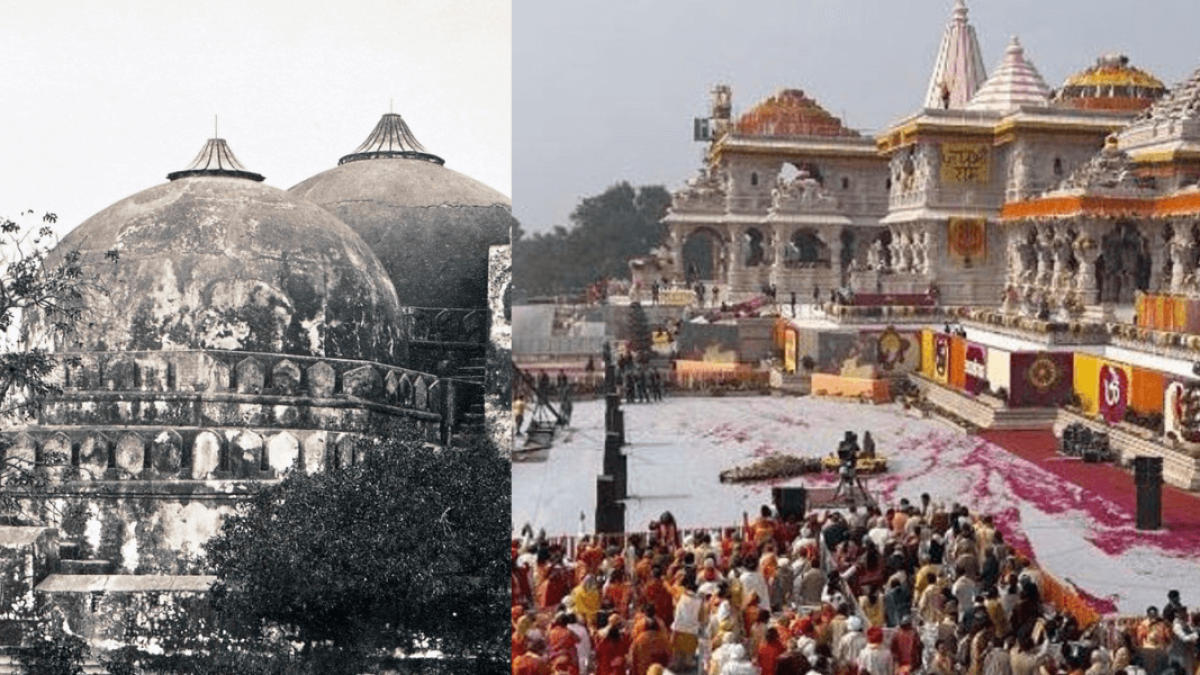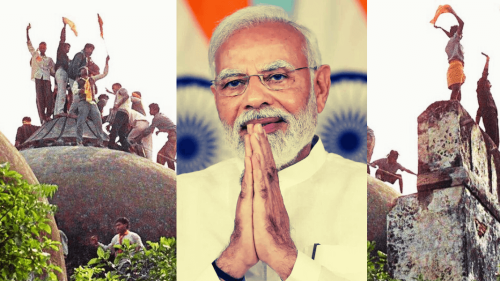Ayodhya Temple: Unveiling Its Controversial Legacy and Political Significance

Historians generally do not believe he existed in real life, yet there are 300 different versions of his story. Many devotees call him the seventh incarnation of Vishnu yet credit him for killing a Shudra to learn Brahmanical scriptures and perform rituals.
Ram is a god in Brahmin mythology, but a god controlled by Brahmins with no will or power of his own. The story says when Ram was ruling Ayodhya, a Brahmin approached the court and told everyone that his young son died due to the misrule of Ram. Ram immediately called a meeting with all his ministers and enquired about the cause. The sage Narada told him this happened due to violating a tapas rule (austerities).
Narada informed him that a shudra was performing tapas, which was denied in the age of Treta. Ram went in search of the shudra and found the place where Shambuka was performing penance. After confirming that Shambuka was indeed a shudra, Rama killed him. The gods praised Rama for this act and congratulated him for protecting their interests and not allowing Shudra to attain heaven in person. Brahmin's son got a new life after the Sudra got killed.
Stories abound of his character as an ideal husband, yet based upon the scriptures, most Hindus believe Rama expelled Mata Sita from the royal palace because the people of Ayodhya had severe concerns about Sita's fidelity, given she had remained near Ravana for so many months. Tulsidas' version denies the abduction of Sita. In Ramcharitramanas, Ravana abducted Sita's clone and not Sita.
Another contradiction exists in the Valmiki and Tulsidas versions about the nature of Hanuman. Valmiki calls him a monkey, while Tulsidas describes Gim as a human. He destroyed Sri Lanka by burning it down. Historically, no such fire burned the town of Ravan. There are no fossils to prove that.
Based on unproven stories, Hindu nationalists have constructed a version of theology that defies reason. They have brainwashed generation after generation, causing the biggest fraud in religious history. Many call Ram the most benevolent character, yet his devotees tore down the masjid in Ayodhya, which they claimed was his birthplace. Ram lived casteism and justified the killing of Sudras.
His followers give 5114 BCE as his birth year. Valmiki wrote his story in 300 BC in Sanskrit, claiming to have met him. The legend says that Ram ruled for 11,000 years. Based on his birth year and the reign of his rulership, he may still be alive overseeing the destruction of the Babri Masjid and directing the Indian Supreme Court in its decision to give Ram Lalla the possession of land.
What a way to celebrate a diety claiming to own the universe after making it. Hindu nationalists claim that the Babri Masjid was the actual birthplace of Rama, which is another myth perpetuated by devotees. Many Historians state that such claims of the Babri Masjid site being the birthplace of Ram sprang up only after the 18th century. Ayodhya emerged as a place of Hindu pilgrimage only in medieval times since ancient texts do not mention it as a pilgrim center. For example, chapter 85 of the Vishnu Smriti lists 52 places of pilgrimage, which do not include Ayodhya.
Many also claim that the present-day Ayodhya was originally a Buddhist site, based on its identification with Saketa described in Buddhist texts. According to historian Romila Thapar, ignoring the Hindu mythological accounts, the first historical mention of the city dates back to the 7th century, when the Chinese pilgrim Xuanzang described it as a Buddhist site.
Ayodhya Temple, the birthplace of Ram, is a religious myth used by the Hindu fascists to mobilize Hindus against Islam and Muslims. Ram is a weapon in the hands of fascists to fan hatred and reassert the Upper caste hegemony.
Hindu religious teachers opposed the Temple's inauguration, not because it was wrong to do so, but because it was wrong to consecrate a half-done Temple. None of them spoke against the demolition of a mosque. There is no history to prove that Muslims demolished an existing temple to build a mosque. The claim that the Babri Masjid was the birthplace of Rama is false.
There is no record of a temple built by Ram's devotees where the present Temple stands.
Do the Hindu nationalists intend to use the Temple for electoral purposes? Many would believe so. They think that anti-Islam electoral politics will win the elections and unite Hindus divided between 30 million deities and thousands of castes.
The nationalists want to build an India full of hatred and animosity against Islam, Christianity, Buddhism, and Sikhism to give legitimacy to a structured system of inequality. India is in control of a caste that believes in its superiority.
The Temple is a symbol of Hindutva terror and violence. Its existence would always remind the religious people of the world of the tyranny of Hindu fascists. The Temple was built based on its birth. It uses scriptures to justify the division. As long as casteis is part of Hinduism, it will remain a fascist ideology. The Ayodhya Temple is a living testimony of human inequality promoted by Hindutva.
The demolition of the Babri Masjid was carried out on December 6, 1992, by a large group of Hindus, the Vishva Hindu Parishad, and allied organizations.
In the 1980s, the Vishva Hindu Parishad (VHP) began a campaign to construct a temple dedicated to Ram at the site, with the Bharatiya Janata Party (BJP) as its political voice. On December 6, 1992, the VHP and the BJP organized a rally at the site involving 150,000 Hindus. The rally turned violent, and the crowd overwhelmed security forces and tore down the mosque. A subsequent inquiry into the incident found 68 people responsible, including several leaders of the BJP and the VHP.
For at least four centuries, the site was used for religious purposes by both Hindus and Muslims. The claim that the mosque stood on the site of a temple was first made in 1822 by an official of the Faizabad court.
The Nirmohi Akhara sect cited this statement in laying claim to the site later in the 19th century, leading to the first recorded incidents of religious violence at the site in 1855.
In 1859, the British colonial administration set up a railing to separate the outer courtyard of the mosque to avoid disputes. The status quo remained in place until 1949, when idols of Rama were secretly placed inside the mosque, allegedly by Hindu Mahasabha activists.
This led to an uproar, with both parties filing civil suits laying claim to the land. The placement of the idols was seen as a heresy by the users of the Masjid. The site was declared to be in dispute, and the gates to the Masjid were locked.
In the 1980s, the Vishva Hindu Parishad (VHP) began a campaign to construct a temple dedicated to Rama at the site. The movement was bolstered by a district judge's decision, who ruled in 1986 that the gates would be reopened and Hindus permitted to worship there. Indian National Congress politician Rajiv Gandhi endorsed this decision, then the Prime Minister of India.
In September 1990, BJP leader L. K. Advani began a Rath Yatra, a political rally traveling across much of north India to Ayodhya. The yatra sought to generate support for the proposed Temple and also sought to unite Hindu votes by mobilizing anti-Muslim sentiment. The Government of Bihar arrested Advani before he could reach Ayodhya.
Despite this, a large body of Sangh Parivar supporters reached Ayodhya and attempted to attack the mosque. This resulted in a pitched battle with the paramilitary forces that ended with the death of several rioters. The BJP withdrew its support to the V. P. Singh ministry, necessitating fresh elections. The BJP substantially increased its tally in the union parliament and won a majority in the Uttar Pradesh assembly.
On December 6, 1992, the RSS and its affiliates organized a rally involving 150,000 VHP and BJP supporters at the site of the disputed structure. The ceremonies included speeches by BJP leaders such as Lal Krishna Advani, Murli Manohar Joshi, and Uma Bharti. During the first few hours of the rally, the crowd grew increasingly restless and began raising slogans. A police cordon had been placed around the structure in preparation for an attack.
However, around noon, a young man managed to slip past the cordon and climb the system itself, brandishing a saffron flag. The mob saw this as a signal and stormed the structure. The police cordon, vastly outnumbered and unprepared for the size of the attack, fled. The mob set upon the building with axes, hammers, and grappling hooks, and within a few hours, the entire structure, made from mud and chalk, was leveled.
The then Prime Minister P. V. Narasimha Rao has often been criticized for mishandling the situation. Rao, in his book Ayodhya December 6, 1992 wrote that the demolition was a "betrayal" by the then Chief Minister of Uttar Pradesh, Kalyan Singh, who repeatedly assured the Congress government that the mosque would be protected.
In a March 2005 book, former Intelligence Bureau head Maloy Krishna Dhar claimed that the Babri mosque demolition was planned 10 months by top leaders of the Rashtriya Swayamsevak Sangh (RSS), BJP and VHP, and criticized how the then Prime Minister P. V. Narasimha Rao handled the issue.
Dhar claimed that he was directed to arrange security for a meeting between individuals from the BJP and other constituents of the Sangh Parivar and that the meeting "proved beyond doubt that they (RSS, BJP, VHP) had drawn up the blueprint of the Hindutva assault in the coming months and choreographed the pralaya nritya (dance of apocalypse) at Ayodhya in December 1992".
The RSS, BJP, VHP, and the Bajrang Dal leaders present in the meeting amply agreed to work in a well-orchestrated manner." Claiming that he handed over the meeting tapes to his boss. He asserts that he has no doubts that his boss had shared the contents with the Prime Minister (Rao) and the Home Minister (Shankarrao Chavan). The author claimed that there was a silent agreement that Ayodhya offered "a unique opportunity to take the Hindutva wave to the peak for deriving political benefit."
In April 2014, a sting operation by Cobrapost claimed that the demolition was not an act of frenzied mobs but sabotage planned with so much secrecy that no government agency got wind of it. It further said that VHP and Vjv Sena frew the plan. Later, the BJP government and the Courts would follow the plan, and Shiv Sena drew the plan.
Topics: Ayodhya Temple, Babri Masjid, Hindutva, India, Narendra Modi
Views:591
Related Suggestions
















